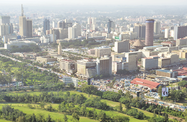Kenya has inaugurated a new multibillion-dollar railway, with the long-awaited project just one of several that the government has been aggressively developing under its Vision 2030 economic blueprint.

The $3.8bn Mombasa-Nairobi Standard-Gauge Railway (SGR) was inaugurated by President Uhuru Kenyatta at the end of May.
Construction and trackwork of the 472-km line began in 2013 and was handled by China Road and Bridge Corporation. The railway is overseen by state-run Kenya Railways, with around 90% of the project’s cost financed by the Exim Bank of China and the rest funded by the Kenyan government.
The new rail link is expected to have a significant impact. Among its biggest anticipated effects will be to reduce the cost of carrying cargo between the country’s two largest cities – its main port and its commercial and political capital – by half, to $480 per container.
With each freight train capable of transporting 4000 tonnes and a total cargo-carrying capacity of 22m tonnes per year the new rail line will be able to carry 40% of the throughput at Port of Mombasa.
A further aim is to alleviate traffic congestion and reduce the journey time for passengers going between the two cities, easing travel to the capital for the region’s estimated 300m residents. Three daily services will ply the line, two express and one local, with capacity for 3600 passengers.
“Trains on the Madaraka Express intercity service between Nairobi and Mombasa are already full, with approximately 1360 passengers per train and 2800 trips per day. The journey takes just 4.5 hours, compared to a nine- to 12-hour journey by road,” Atanas Maina, managing director of Kenya Railways, told OBG. “Given the strong initial uptake, we are already looking at expanding the service in the coming months."
Full pipeline
The SGR is one of the biggest infrastructure projects the government has completed in recent years. More are expected to follow, should all go to plan, with several large-scale undertakings in the pipeline in various sectors under the aegis of Vision 2030.
One such project is the Olkaria V power plant in Naivasha, in the Nakuru district 100 km north-west of Nairobi. At the end of April, President Kenyatta marked the beginning of construction on the plant, which is set to generate 158 MW of electricity by harnessing geothermal energy. The government expects it to be completed by October 2018.
Japan’s International Cooperation Agency provided the funding for the KSh40bn ($387.1m) plant, which will include two geothermal units, each with a generation capacity of 79 MW.
Olkaria V is the latest in a series of geothermal energy plants set to generate a total of 558 MW, with the segment to become the country’s top source of power generation by 2030.
Vision 2030 calls for 26% of power to come from geothermal sources, 19% from nuclear, 13% from coal, 11% from liquefied natural gas, 9% each from wind and thermal, and 5% from hydro, with the remaining 17% coming from imports.
Kenyan authorities plan to surpass 5000 MW of capacity by 2020, with Kenya Electricity Generating Company alone targeting 33,000 MW of capacity by 2030. This expansion should help to sustainably meet increasing power demand, which is expected to grow by 11% per year until 2020.
Overcoming challenges
Launched in 2008, the Vision 2030 strategy ultimately aims to transform Kenya into an industrialising, middle-income country by 2030 at an ambitious pace of 10% GDP growth per year.
Implementing Vision 2030 does mean the government will have to navigate some challenging macroeconomic headwinds. Consumer price inflation has affected projects, rising by 11.7% in May driven largely by drought. This figure represents a five-year high and is far above the 2.5-7.5% target range set by Central Bank of Kenya.
Higher inflation could widen the current account deficit, potentially reversing its recent fall from 10% in 2014 to 5.2% in 2016. Indeed, on May 30 the central bank’s governor said the figure was likely to hit 5.8% this year, partly due to increased imports of rolling stock for the SGR project.
However, the country’s economic outlook in the medium term looks bright. There is some way to go before Kenya hits the growth targets under Vision 2030, but incremental increases are moving it in the right direction. In its most recent World Economic Outlook the IMF forecasts expansion of 5.25% this year, rising to 5.7% in 2018.


